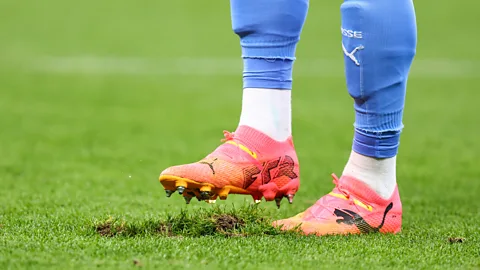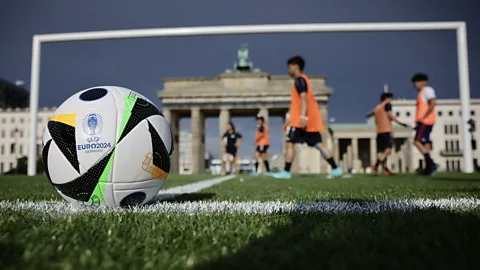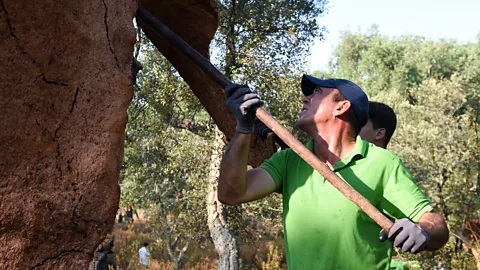Grass pitches are taking criticism at the Euros, but are there other natural alternatives?

 Getty Images
Getty ImagesTens of thousands of tonnes of rubber crumbs and artificial grass from pitches end up in the sea, research shows. Could natural alternatives help to stop the pollution?
When Queens Park Rangers became the first professional English club to install a synthetic pitch at their Loftus Road ground in 1981, it raised eyebrows. Made of a concrete base with a nylon carpet-like fabric layer and sand spread over the top, the new pitch caused the to ball move faster and bounce further than their opponents were used to. Some commented that QPR were now "fantastic on plastic", as the ball zipped between players. But not everyone was convinced.
One football manager recalled seeing goal kicks bounce once on the rock hard surface and sail over the opposition's crossbar out of play. And the all-weather surface was hard-wearing in more ways than one – it would leave players with horrible cuts and grazes.
QPR's pitch was later removed after England's Football Association banned plastic pitches in 1988 due to higher rates of injuries and inconsistent playability. In the US, athletes including NFL players have also pushed for changing synthetic field surfaces to natural grass to prevent injuries.
However, natural pitches, made with carefully selected, hard-wearing grasses, can also be problematic: they need to be replaced frequently, consume a lot of water, and can turn into treacherous, muddy traps for the players. Pundits covering the Euro 2024 matches have criticised the grass pitch in Frankfurt's Waldstadion, which replaced a synthetic-natural hybrid pitch, calling it "a mess" and emphasising that slipping and sliding on cut-up turf can impact performance as players worry about getting injured.
Germany coach Julian Nagelsmann said the turf was a "catastrophe" and that players "risked serious injury".
Today, most top-tier football pitches are a hybrid – essentially a synthetic mat through which real grass can grow. These pitches feel like natural grass – the ball bounces consistently, they are softer underfoot and can be resown with new grass each year. Importantly, they are also hard-wearing, much better at draining and can recover quickly, so can be used for things other than football.
As the clubs with the biggest stadiums look for alternative ways to make money, in the summer months football grounds are turned into music venues, with acts like Beyoncé, Ed Sheeran, Pink and Taylor Swift playing in front of tens of thousands of fans across the UK in recent years.
In total, only about 3-5% of the playing surface of these top-tier pitches is synthetic. Importantly, they don't use rubber crumbs: tiny, polluting particles that can end up in the ocean. But, these hybrid pitches cost millions of pounds to install and are only affordable to the highest-earning professional sides. For ordinary community pitches, is there a way to make hard-wearing, affordable surfaces, without returning to the 80s and 90s knee-grazers?
Plastic in the sea
Modern "third generation" (or 3G) artificial pitches are made with a shock-absorbing baselayer of rubber which is covered in a matting of 4-6.5cm (1.6-2.4in) long polypropylene or polyethylene fibres. This is then coated with a layer of sand and then an "infill" layer of small rubber pellets called crumbs. This rubber crumb is typically made from recycled car tyres in the EU.
Anyone who has played on these pitches will be familiar with how far and wide these little rubber pellets can travel. Hitchhiking their way home in the crevices of your trainer tread. Tucked into gaps between sock and sole. Squirrelled away in the darkest corners of your gym bag. They get everywhere.
The rubber also has a habit of finding its way into other unwanted places.
 Getty Images
Getty ImagesA standard 11-a-side football pitch measuring 106m by 71m (350ft by 234ft) is covered with 120 tonnes of rubber crumb. Between 1.5 and five tonnes of rubber crumb is lost to the environment from a full-size pitch every year. When extrapolated across Europe's 51,000 synthetic pitches of various sizes, this means between 18,000 and 72,000 tonnes of rubber could be lost, according to one estimate. (Many 3G pitches are smaller than full-size, which is why the smallest figure is not 51,000 x 1.5.)
Then there's the artificial grass blades – not only from sport pitches including football, golf, rugby and field hockey, but also, private gardens, playgrounds and rooftops with astroturf. One study in Spain found 213,200 astroturf fibres per sq km (552,188 per sq mile) in rivers and sea surface waters. About half of the fibres were classified as microplastics, as the long blades had degraded into tiny pieces. "Extensive replacement of natural land covers by [artificial turf] surfaces will likely add a significant and irreparable plastic legacy to the global [environment]," including the aquatic environment, the study's authors warned.
Most of these microplastics end up in watercourses after being washed down drains. Simon Hann, who studies lifecycle assessments for the consultation and research group Eunomia, says some groundstaff might have previously tipped plastic into waterways when clearing pitches of snow. "I've seen pictures where it's just a mass of snow and tyre particles, and they typically would just dump that in a river or the local water course," he says.
Countries where synthetic pitches and snow are common – like Norway – now have stricter rules about how to maintain 3G pitches in snow, he adds.
Cool cork
In 2023, the European Commission announced a restriction on the sale of intentionally added microplastics, including rubber crumb for 3G pitches. From October 2031, EU countries will not be able to purchase new rubber crumb. This doesn't outlaw the use of 3G pitches, but will make their maintenance with microplastic much harder. New synthetic pitches without a rubber crumb will be needed, and organic alternatives like cork, coconut shell and bark are being explored.
In one pilot project, Schagen United, an amateur football club in the Netherlands, has tested a pitch that combines artificial turf and an infill made from cork granules and olive pits, with a positive response from the players. The olive pits were added for stability, while cork's natural bounciness helped keep the players safe.
To make cork crumb, the bark of cork trees is harvested and turned into granules, a process that does not kill the cork tree. Cork also has climate benefits: cork oaks are one of the few commercial forests not felled for harvesting, and a cork tree's carbon storage capacity keeps increasing during its long life. (Read the BBC's in-depth report on the surprising environmental benefits of cork).
 Getty Images
Getty ImagesAnother issue with rubber 3G pitches is that they can become too hot, and players might burn themselves on the rubber, adds Hann. In fact, systematic review of research on synthetic grass and temperature found that the air and surface temperatures were consistently higher with synthetic grass compared to natural grass. There have been concerns that hot synthetic turf can melt shoes and harm the players' health, and, when used in community sports fields, worsen children's risk of heat stress. Cork doesn't have this problem.
However, cork may not suit all pitches, says Hann.
"Materials like cork, which don't absorb as much heat, are much better and longer-lasting in warmer climates," says Hann. "But in wetter climates, it doesn't always make sense because it can get washed away, biodegrades faster and needs to be replaced more often."
Waste materials like coconut husk have been used, but "the performance wasn't quite as good because you don't get the cushioning as much as cork or rubber", he says.
Limiting the environmental impact of synthetic pitches will have another benefit: a natural field measuring 9,000 sq m (96,875 sq ft) which is large enough for two 11-a-side pitches, will sequester 16.9 tonnes of CO2e over 10 years. A synthetic pitch will result in emissions equal to 55.6 tonnes of CO2e, mostly from the production of the plastics in the pitch.
But it's no surprise synthetic pitches are popular. With climate change resulting in rising temperatures and increased flooding, natural pitches are becoming harder to keep playable.
One club is able to spend up to 80 hours playing and training on the same 3G pitch every week – and can rent it out to other sides in the community. This is a much higher figure than a grass pitch could support. "There are guidelines on pitch use because it depends on the construction, level of football, prevailing weather conditions, and who is playing on it (i.e. adults or children)," says Andrew Carmichael, a senior research assistant at the University of Central Lancashire in the UK.
A soil pitch with no drainage might only be able to support 90 minutes of football per week after heavy rain. "For a pitch with artificial drainage, playability might increase to four to five hours," says Carmichael, who is also a former pitch assessor and a trustee of his local community football club. "With drainage and proper sand and soil rootzones – maybe six hours if the weather has been helpful. Not even close to 80 hours!"
So what can be done about the community synthetic pitches we already have? "Things like barriers around the pitches and capture devices in all of the drains are very basic and actually quite cheap measures to make sure particles don't just go straight down into the watercourses," says Hann.
Meanwhile, natural turf will probably continue to come under scrutiny should it fall below standard. Uefa said they would address the below-par Frankfurt pitch, but there's no overnight solution to fixing poor natural grass. For the time being, players might have to get used to sliding about on the natural – but potentially slippery – surface.
--
If you liked this story, sign up for The Essential List newsletter – a handpicked selection of features, videos and can't-miss news, delivered to your inbox twice a week.
For more science, technology, environment and health stories from the BBC, follow us on Facebook and X.
